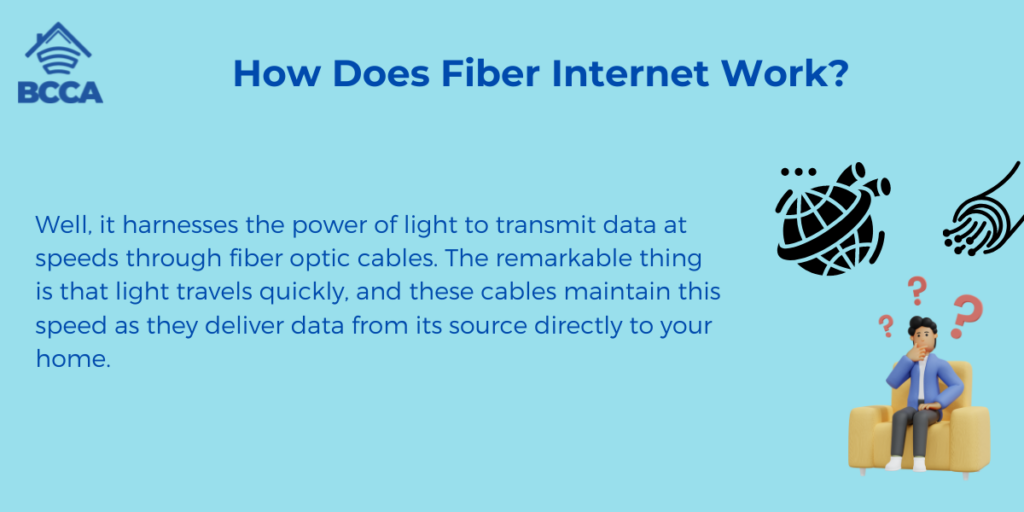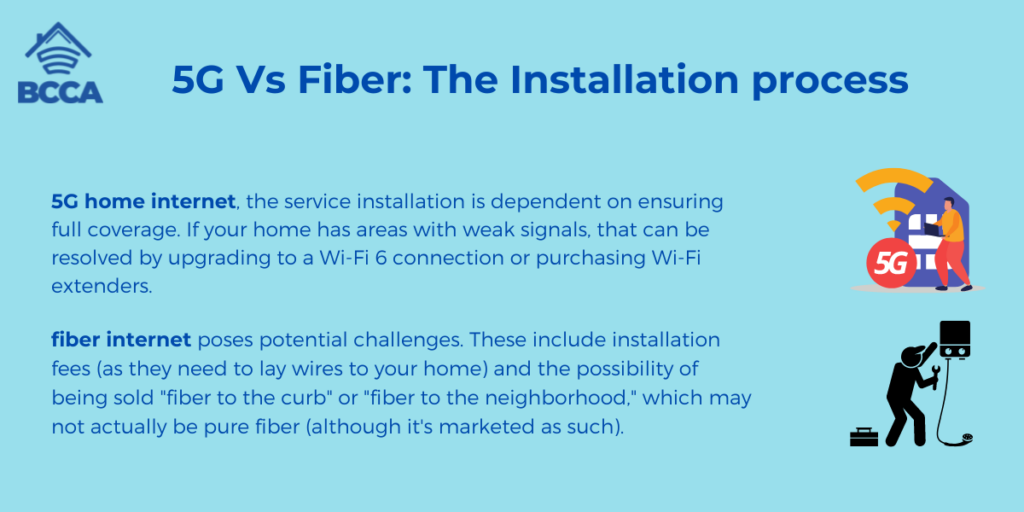If you’re comparing 5G home internet with fiber internet, it’s clear that you’re seeking high-speed internet. However, what sets these two fast technologies apart?
Fiber infrastructure is expanding rapidly and relies on a wired network, which can be costly. On the other hand, 5G home internet is still in its early stages but operates wirelessly and has immense potential for quick growth. It uses the 5G networks of carriers like Verizon and T Mobile.
In the coming time, both 5G home and fiber internet will extend their coverage in the broadband community. But which one is ideal for your needs?
The best approach is to highlight the distinctions between these two technologies allowing you to decide which suits you better. So, in this article, we will explore the differences and see which offers faster speeds and better performance.
Table of Contents
5G Home Internet Vs FiOS: The Difference
Fiber internet is a technology that utilizes fiber optic cables to provide fast internet access to your home. However, the main challenge lies in the cost of laying these cables.
On the other hand, 5G home internet relies on cell antennas strategically placed throughout towns or cities. These antennas are wireless and eliminate the need for infrastructure.
However, they have limited coverage and require multiple nodes to ensure connectivity within each specific area. If you use a mobile phone, chances are you must be familiar with 5G technology!
1. How Does Fiber Internet Work?

Well, it harnesses the power of light to transmit data at speeds through fiber optic cables. The remarkable thing is that light travels quickly, and these cables maintain this speed as they deliver data from its source directly to your home. Pretty fascinating, isn’t it?
While fiber internet continues to expand its reach into locations, it remains primarily available in cities and suburbs. Despite network growth efforts, there are still areas where connecting to fiber internet is not yet feasible.
If you want a fiber company to set up a connection for you, the costs can be quite expensive.
2. How does 5G Home Internet Work?
Mobile companies must install cell towers, or “nodes” on wired fiber networks for 5G internet to function properly. These nodes then transmit data to your home router, and your Wi-Fi modem distributes the data to your devices.
In some situations, the speed of the 5G network matches that of fiber internet. However, it still faces challenges that don’t affect fiber broadband, like network congestion and weak signals.
To address this, mobile companies must deploy towers in densely populated areas.
5G Vs Fiber: Speeds
When it comes to speed, fiber internet, and 5G home internet plans are quite competitive, and both have the potential to reach very high speeds. They differ in how they deliver the connection to your home.
One thing to watch out for with fiber plans is that sometimes they are labeled as “fiber,” even when they aren’t entirely made of fiber. Some customers may sign up for a “fiber plan” with a speed of 100Mbps hoping to upgrade if needed.
However, if the cable connecting to your home cannot handle gig speeds, you won’t benefit much from a fiber plan. The crucial factor in your fiber plan is the type of cable that leads directly to your door, regardless of what providers claim.
In contrast, 5G wireless broadband doesn’t face this limitation. However, signal strength and network congestion can affect your speeds. Even though 5G home internet can surpass fiber speeds, you might experience speeds if there aren’t small cell towers nearby or if too many people use the service simultaneously.
The great thing is that as more towers are installed, you will start noticing a decrease in the number of issues.
5G Vs Fiber: The Installation Process

Both 5G home internet and fiber internet require the use of a router and Wi-Fi modem to deliver data to your home and devices.
When it comes to 5G home internet, the service installation is dependent on ensuring full coverage. If your home has areas with weak signals, that can be resolved by upgrading to a Wi-Fi 6 connection or purchasing Wi-Fi extenders.
On the other hand, fiber internet poses potential challenges. These include installation fees (as they need to lay wires to your home) and the possibility of being sold “fiber to the curb” or “fiber to the neighborhood,” which may not actually be pure fiber (although it’s marketed as such).
In these cases, data speeds are limited by the wires used up until your doorstep, which can result in speeds. Additionally, there might be dead zones within your home. While Wi-Fi boosters can improve dead zones, little can be done about fees or accidentally signing up for the wrong plan type.
1. For Fiber Internet
Some installation fees can go as high as $1,000, so make sure to read the details. You’ll require a modem and Wi-Fi router, and some fiber companies offer the option to rent these devices for a fee.
Once your wired connection is activated, you can either pay them to install your router and Wi-Fi modem or do it yourself. If your home exceeds 1,600 feet in size, you may need Wi-Fi routers to ensure that every area of your home has internet coverage.
2. For 5G Internet
When it comes to 5G home internet, you will need a modem and router. Professional assistance is necessary for installing 5G home internet; however, this requirement may change over time.
During installation, a technician will strategically place Wi-Fi extenders throughout your home to prevent any zones.
Frequently Asked Questions
5G Home Internet: 5G speeds can vary based on factors like distance from the tower and network congestion. It can offer speeds comparable to traditional broadband, typically ranging from 100 Mbps to 1 Gbps.
FiOS: FiOS is known for its consistently high speeds. It can offer symmetrical speeds (same upload and download) of up to 1 Gbps or more, making it one of the fastest residential internet options.
FiOS is typically more widely available in established areas, especially urban and suburban regions. 5G Home Internet availability depends on the rollout of 5G infrastructure in your specific location.
FiOS tends to have lower latency and higher reliability due to its dedicated fiber-optic lines. 5G Home Internet can have higher latency and may be susceptible to disruptions caused by interference or distance from the 5G tower.
Final Verdict
Service providers are expanding their coverage for home broadband with the introduction of 5G home internet service.
Even if the quality of 5G service isn’t perfect, it still offers an option and promotes more competition in the market. It benefits consumers by encouraging innovation and keeping prices affordable.
The availability of FiOS might be limited at the moment due to the need for fiber installation and trench digging. If you have access to FiOS internet, go for it since even their 300 Mbps tier provides speeds suitable for most people’s needs.
If you don’t have access to FiOS but have access to 5G home internet, explore your options. Look at what your local cable provider offers; in some cases, cable internet comes as a second in terms of performance compared to fiber-based internet.
If cable internet isn’t available or you prefer not to rely on the provider, then 5G internet could be an alternative. However, it may be best to avoid relying on 5G home internet if you’re a gamer outside of areas covered by millimeter-wave technology.
Chris loves technology, specifically smart home technology! With both hands-on and executive leadership experience in his corporate career, Chris stays abreast of emerging technology and solutions and immerses himself in BCCA when not in the office.
